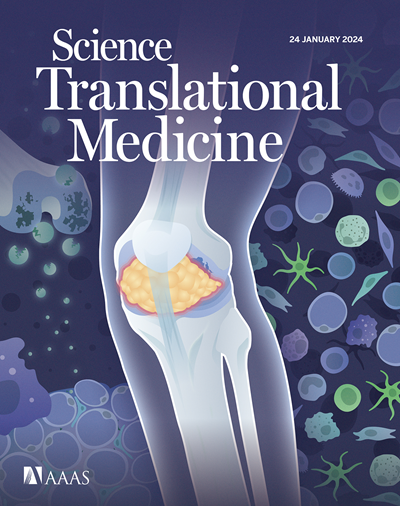不同的NKT细胞调节心脏骤停和复苏后的早期炎症和神经系统预后。
IF 15.8
1区 医学
Q1 CELL BIOLOGY
引用次数: 0
摘要
在院外心脏骤停(OHCA)住院患者中,神经损伤是导致大多数死亡和发病的原因。尽管具有重要的临床意义,但目前还没有针对心脏骤停后神经损伤的有效药物治疗方法。在这里,我们分析了大量OHCA患者的循环免疫细胞,发现淋巴细胞减少与神经系统预后差独立相关。免疫细胞的单细胞RNA测序显示,具有先天T细胞和自然杀伤(NK)细胞特征的T细胞在神经系统预后良好的患者中增加。我们更具体地发现,在另一组神经预后良好的OHCA患者中,循环多种NKT (dNKT)细胞的早期增加。这些细胞含有多种T细胞受体,但对硫脂抗原始终具有特异性。在小鼠中,我们发现在CA和复苏后,硫脂特异性dNKT细胞被运输到大脑。在缺乏NKT细胞(Cd1d-/-)的小鼠大脑中,与野生型小鼠相比,我们观察到炎症趋化因子和细胞因子的表达和巨噬细胞的积累增加。CA后,Cd1d-/-小鼠的神经损伤、神经功能障碍和死亡率也有所增加。为了从治疗上增强dNKT细胞活性,我们在CA后用硫脂脂治疗小鼠,结果显示它改善了神经功能。总之,这些数据表明,硫脂特异性dNKT细胞与临床OHCA后良好的神经预后相关,并且在CA后小鼠中具有神经保护作用。因此,增加dNKT细胞数量或功能的策略可能代表CA的治疗方法。本文章由计算机程序翻译,如有差异,请以英文原文为准。
Diverse NKT cells regulate early inflammation and neurological outcomes after cardiac arrest and resuscitation
Neurological injury drives most deaths and morbidity among patients hospitalized for out-of-hospital cardiac arrest (OHCA). Despite its clinical importance, there are no effective pharmacological therapies targeting post–cardiac arrest (CA) neurological injury. Here, we analyzed circulating immune cells from a large cohort of patients with OHCA, finding that lymphopenia independently associated with poor neurological outcomes. Single-cell RNA sequencing of immune cells showed that T cells with features of both innate T cells and natural killer (NK) cells were increased in patients with favorable neurological outcomes. We more specifically identified an early increase in circulating diverse NKT (dNKT) cells in a separate cohort of patients with OHCA who had good neurological outcomes. These cells harbored a diverse T cell receptor repertoire but were consistently specific for sulfatide antigen. In mice, we found that sulfatide-specific dNKT cells trafficked to the brain after CA and resuscitation. In the brains of mice lacking NKT cells (Cd1d−/−), we observed increased inflammatory chemokine and cytokine expression and accumulation of macrophages when compared with wild-type mice. Cd1d−/− mice also had increased neuronal injury, neurological dysfunction, and worse mortality after CA. To therapeutically enhance dNKT cell activity, we treated mice with sulfatide lipid after CA, showing that it improved neurological function. Together, these data show that sulfatide-specific dNKT cells are associated with good neurological outcomes after clinical OHCA and are neuroprotective in mice after CA. Strategies to enhance the number or function of dNKT cells may thus represent a treatment approach for CA.
求助全文
通过发布文献求助,成功后即可免费获取论文全文。
去求助
来源期刊

Science Translational Medicine
CELL BIOLOGY-MEDICINE, RESEARCH & EXPERIMENTAL
CiteScore
26.70
自引率
1.20%
发文量
309
审稿时长
1.7 months
期刊介绍:
Science Translational Medicine is an online journal that focuses on publishing research at the intersection of science, engineering, and medicine. The goal of the journal is to promote human health by providing a platform for researchers from various disciplines to communicate their latest advancements in biomedical, translational, and clinical research.
The journal aims to address the slow translation of scientific knowledge into effective treatments and health measures. It publishes articles that fill the knowledge gaps between preclinical research and medical applications, with a focus on accelerating the translation of knowledge into new ways of preventing, diagnosing, and treating human diseases.
The scope of Science Translational Medicine includes various areas such as cardiovascular disease, immunology/vaccines, metabolism/diabetes/obesity, neuroscience/neurology/psychiatry, cancer, infectious diseases, policy, behavior, bioengineering, chemical genomics/drug discovery, imaging, applied physical sciences, medical nanotechnology, drug delivery, biomarkers, gene therapy/regenerative medicine, toxicology and pharmacokinetics, data mining, cell culture, animal and human studies, medical informatics, and other interdisciplinary approaches to medicine.
The target audience of the journal includes researchers and management in academia, government, and the biotechnology and pharmaceutical industries. It is also relevant to physician scientists, regulators, policy makers, investors, business developers, and funding agencies.
 求助内容:
求助内容: 应助结果提醒方式:
应助结果提醒方式:


